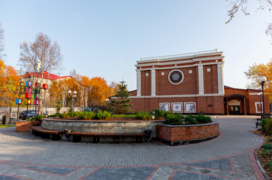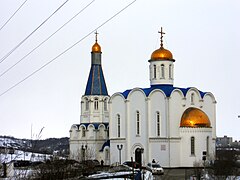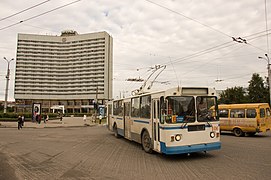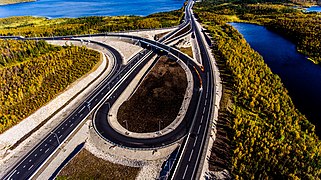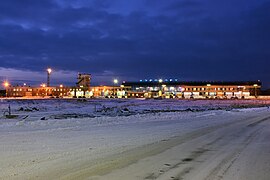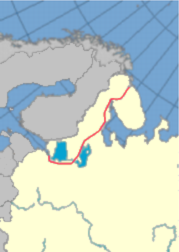Murmansk
City in Murmansk Oblast, Russia From Wikipedia, the free encyclopedia
Murmansk (Russian: Мурманск) is a port city and the administrative center of Murmansk Oblast in the far northwest part of Russia. It is the world's largest city north of the Arctic Circle and sits on both slopes and banks of a modest fjord, Kola Bay, an estuarine inlet of the Barents Sea, with its bulk on the east bank of the inlet. The city is a major port of the Arctic Ocean[10] and is about 100 kilometres (62 mi) from the border with Norway, 180 kilometres (110 mi) from the border with Finland and 1,930 kilometres (1,200 mi) from Moscow.
Murmansk
Мурманск | |
|---|---|
| Other transcription(s) | |
| • Kildin Sami | Мурман ланнҍ |
| • Northern Sami | Murmánska |
| • Skolt Sami | Muurman[2] |
 Murmansk skyline | |
| Coordinates: 68°58′14″N 33°04′30″E | |
| Country | Russia |
| Federal subject | Murmansk Oblast[1] |
| Official foundation date (see text) | 4 October 1916[3] |
| City status since | 19 July 1916[3] |
| Government | |
| • Body | Council of Deputies |
| • Head/Mayor | Dmitry Filippov (Head) Evgeniy Nikora (Mayor) |
| Area | |
• Total | 168.14 km2 (64.92 sq mi) |
| Elevation | 50 m (160 ft) |
| Population | |
| 270,384 | |
| • Subordinated to | City of Murmansk[1] |
| • Capital of | Murmansk Oblast,[1] City of Murmansk[1] |
| • Urban okrug | Murmansk Urban Okrug[6] |
| • Capital of | Murmansk Urban Okrug[6] |
| Time zone | UTC+3 (MSK [7]) |
| Postal code(s)[8] | 183000–183099 |
| Dialing code(s) | +7 8152 |
| OKTMO ID | 47701000001 |
| City Day | 4 October[9] |
| Website | citymurmansk |
Benefiting from the North Atlantic Current, Murmansk resembles cities of its size across western Russia, with highway and railway access to the rest of Europe, and the northernmost trolleybus system on Earth. Its connectivity contrasts with the isolation of Arctic ports like the Siberian Dikson on the shores of the Kara Sea, and Iqaluit, in the Canadian Arctic. Despite long, snowy winters, Murmansk's climate is moderated by the generally ice-free waters around it.
Although there was a building boom in the early twentieth century's arms races, Murmansk's population has been in decline since the Cold War, from 468,039 (1989 Soviet census);[11] 336,137 (2002 Census);[12] 307,257 (2010 Census);[13] to 270,384 (2021 Census).[14]
Etymology
The name of the city is derived from Murman, from an old name for Norwegians by Russians, likely a borrowing from Old Norse norðmaðr, which gave its name to the Murman Coast and the surrounding region including the Kola Peninsula.[15]
History
Summarize
Perspective



Murmansk was the last city founded in the Russian Empire.[16] In 1915, World War I needs led to the construction of the railroad from Petrozavodsk to an ice-free location on the Murman Coast in the Russian Arctic, to which Russia's allies shipped military supplies.[3] The terminus became known as the Murman station and soon boasted a port, a naval base, and an adjacent settlement with a population that quickly grew in size and soon surpassed the nearby towns of Alexandrovsk and Kola.[3][17]
On June 29 [O.S. July 12], 1916, Russian Transport Minister Alexander Trepov petitioned to grant urban status to the railway settlement.[3] On July 6 [O.S. July 19], 1916, the petition was approved and the town was named Romanov-on-Murman (Рома́нов-на-Му́рмане, Romanov-na-Murmane), after the Imperial Russian dynasty, the Romanovs.[3] On September 21 [O.S. October 4], 1916, the official ceremony was performed,[3] and the date is now considered the official date of the city's foundation. After the February Revolution of March 1917, on April 3 [O.S. April 16], 1917, the town was given its present name.[18]

In the winter of 1917 the British North Russia Squadron under Rear Admiral Thomas Kemp was based at Murmansk.[19]
From 1918 to 1920, during the Russian Civil War, the town was occupied by the Western powers, who had been allied in World War I, and was also controlled by White Army forces.[20]
On February 13, 1926, local self-government was organized in Murmansk for the first time, during a plenary session of the Murmansk City Soviet, which elected a Presidium.[18] Before this, the city was governed by the authorities of Alexandrovsky Uyezd and later of Murmansk Governorate.[18] On August 1, 1927, the All-Russian Central Executive Committee (VTsIK) issued two resolutions: "On the Establishment of Leningrad Oblast" and "On the Borders and Composition of the Okrugs of Leningrad Oblast", which transformed Murmansk Governorate into Murmansk Okrug within Leningrad Oblast and made Murmansk the administrative center of Murmansk Okrug.[18]
In 1934, the Murmansk Okrug Executive Committee developed a redistricting proposal, which included a plan to enlarge the city by merging the surrounding territories in the north, south, and west into Murmansk.[18] While this plan was not confirmed by the Leningrad Oblast Executive Committee, in 1935–1937 several rural localities of Kolsky and Polyarny Districts were merged into Murmansk anyway.[18]
According to the Presidium of the Leningrad Oblast Executive Committee resolution of February 26, 1935, the administrative center of Polyarny District was moved from Polyarnoye to Sayda-Guba.[21] However, the provisions of the resolution were not fully implemented, and due to military construction in Polyarnoye, the administrative center was instead moved to Murmansk in the beginning of 1935.[21] In addition to being the administrative center of Murmansk Okrug, Murmansk continued to serve as the administrative center of Polyarny District until September 11, 1938.[18] On February 10, 1938, when the VTsIK adopted a Resolution changing the administrative-territorial structure of Murmansk Okrug, the city of Murmansk became a separate administrative division of the okrug, equal in status to that of the districts.[18] This status was retained when Murmansk Okrug was transformed into Murmansk Oblast on May 28, 1938.[18] The Germans were promised the use of the port they called Norwegenhafen for transportation of goods and raw materials from 1922 to 1941.
During World War II, Murmansk was a link to the Western world for the Soviet Union, with large quantities of goods important to the respective military efforts traded with the USSR's Allies: primarily military equipment, manufactured goods and raw materials brought into the Soviet Union. The supplies were brought to the city in the Arctic convoys.[22]
German forces in Finnish territory launched an offensive against Murmansk in 1941 as part of Operation Silver Fox. Fierce Soviet resistance and harsh local weather, with the bad terrain, prevented the Germans from capturing it. The Luftwaffe bombed the city 792 times during World War II.[23] Murmansk suffered extensive destruction, the magnitude of which was rivaled only by the destruction in Leningrad and Stalingrad.[24][25]
For the rest of the war, Murmansk served as a transit point for weapons and other supplies entering the Soviet Union from other Allied nations. The city's resistance was commemorated at the 40th anniversary of the victory over the Germans in the formal designation of Murmansk as a Hero City on May 6, 1985.[26] During the Cold War Murmansk was a center of Soviet submarine and icebreaker activity. After the dissolution of the Soviet Union, the nearby city and naval base of Severomorsk remains the headquarters of the Russian Northern Fleet.
In 1974, a massive 35.5-meter (116 ft) tall statue Alyosha, depicting a Soviet World War II soldier, was installed on a 7-meter (23 ft) high foundation.[27] The Hotel Arctic opened in 1984, becoming the tallest building above the Arctic Circle.
On January 1, 2015, the territory of Murmansk was expanded when the urban-type settlement of Roslyakovo, previously under the jurisdiction of the closed administrative-territorial formation of Severomorsk, was abolished and its territory merged into Murmansk.[28]
Administrative and municipal status
Summarize
Perspective
Within the framework of administrative divisions, it is incorporated as the City of Murmansk—an administrative unit with the status equal to that of the districts.[1] As a municipal division, the City of Murmansk is incorporated as Murmansk Urban Okrug.[6]
City divisions

As of 2012[update], the city is divided into three administrative okrugs:[29]
- Leninsky (Ленинский (Lenin))
- Oktyabrsky (Октябрьский (October))
- Pervomaysky (Первомайский (First May))
City districts were established in Murmansk for the first time by the Decree of the Presidium of the Supreme Soviet of the Russian SFSR of April 20, 1939; at the time, three city districts (Kirovsky, Leninsky, and Mikoyanovsky) were created.[18] They were abolished on June 2, 1948.[18] The same city districts were created for the second time on June 23, 1951.[18]
Mikoyanovsky City District was renamed Oktyabrsky on October 30, 1957, but on September 30, 1958, all three city districts were again abolished.[18] On June 10, 1967, two city districts were created (Leninsky and Oktyabrsky); Pervomaysky City District was split from Oktyabrsky on February 21, 1975.[18] In the Charter of the Hero City of Murmansk, adopted on December 17, 1995, the districts started to be referred to as administrative okrugs.
Geography
Summarize
Perspective

Climate
Murmansk experiences a subarctic climate (Köppen Dfc), with long and cold (though average by arctic standards) winters and short, cool summers. In the city, freezing temperatures are routinely experienced from October to May. Average temperatures exceed 0 degrees Celsius only from May through October. The average low during the coldest part of the year in Murmansk is approximately −14 °C (7 °F). However, temperatures routinely plunge below −20 °C (−4 °F) during the winter.
Murmansk's brief summer is mild, with average highs in July exceeding +17 °C (63 °F). The city is slightly wetter during the summer than the winter and receives an annual average of just under 500 mm (20 in) of precipitation.
The "midnight sun" is above the horizon from 22 May to 23 July (63 days), and the period with continuous darkness is somewhat shorter — the polar night lasts from 2 December to 10 January (40 days).
Extreme temperatures range from −39.4 °C (−38.9 °F) on January 6, 1985, and January 27, 1999, up to 32.9 °C (91.2 °F) on July 9, 1972; the record cold daily maximum is −36.1 °C (−33.0 °F), set on January 6, 1985, while, conversely, the record warm daily minimum is 21.3 °C (70.3 °F) last set on July 9, 1972.[30]
Murmansk has been affected by global warming in recent decades, similar to other Arctic locations. For example, December 2007 had an average high of 0.8 °C (33.4 °F), while a 2.3 °C (36.1 °F) average high was measured for March 2007.[31][32] Summer has also been affected, with a 19.1 °C (66.4 °F) average high for June 2013, and a 24.3 °C (75.7 °F) average high during July 2018.[33][34]
| Climate data for Murmansk (1991–2020, extremes 1918–present) | |||||||||||||
|---|---|---|---|---|---|---|---|---|---|---|---|---|---|
| Month | Jan | Feb | Mar | Apr | May | Jun | Jul | Aug | Sep | Oct | Nov | Dec | Year |
| Record high °C (°F) | 7.0 (44.6) |
6.6 (43.9) |
9.0 (48.2) |
17.6 (63.7) |
29.4 (84.9) |
30.8 (87.4) |
32.9 (91.2) |
30.2 (86.4) |
24.2 (75.6) |
15.0 (59.0) |
11.7 (53.1) |
7.2 (45.0) |
32.9 (91.2) |
| Mean maximum °C (°F) | 1.7 (35.1) |
2.0 (35.6) |
4.5 (40.1) |
10.3 (50.5) |
19.1 (66.4) |
24.4 (75.9) |
26.9 (80.4) |
23.9 (75.0) |
17.8 (64.0) |
9.7 (49.5) |
3.9 (39.0) |
2.9 (37.2) |
27.7 (81.9) |
| Mean daily maximum °C (°F) | −6.5 (20.3) |
−6.4 (20.5) |
−1.9 (28.6) |
2.9 (37.2) |
8.4 (47.1) |
13.8 (56.8) |
17.7 (63.9) |
15.3 (59.5) |
10.7 (51.3) |
3.6 (38.5) |
−1.8 (28.8) |
−4.1 (24.6) |
4.3 (39.7) |
| Daily mean °C (°F) | −9.6 (14.7) |
−9.3 (15.3) |
−5.1 (22.8) |
−0.3 (31.5) |
4.6 (40.3) |
9.4 (48.9) |
13.2 (55.8) |
11.5 (52.7) |
7.6 (45.7) |
1.6 (34.9) |
−4.0 (24.8) |
−6.8 (19.8) |
1.1 (34.0) |
| Mean daily minimum °C (°F) | −12.7 (9.1) |
−12.3 (9.9) |
−8.2 (17.2) |
−3.3 (26.1) |
1.5 (34.7) |
5.9 (42.6) |
9.6 (49.3) |
8.3 (46.9) |
5.1 (41.2) |
−0.3 (31.5) |
−6.2 (20.8) |
−9.6 (14.7) |
−1.8 (28.8) |
| Mean minimum °C (°F) | −25.1 (−13.2) |
−24.4 (−11.9) |
−19.1 (−2.4) |
−12.1 (10.2) |
−3.8 (25.2) |
1.2 (34.2) |
5.2 (41.4) |
3.2 (37.8) |
−0.4 (31.3) |
−8.1 (17.4) |
−16.4 (2.5) |
−20.7 (−5.3) |
−28.5 (−19.3) |
| Record low °C (°F) | −39.4 (−38.9) |
−38.6 (−37.5) |
−32.6 (−26.7) |
−24.0 (−11.2) |
−10.3 (13.5) |
−2.8 (27.0) |
1.7 (35.1) |
−2.0 (28.4) |
−10.1 (13.8) |
−21.2 (−6.2) |
−32.2 (−26.0) |
−34.9 (−30.8) |
−39.4 (−38.9) |
| Average precipitation mm (inches) | 34 (1.3) |
24 (0.9) |
29 (1.1) |
29 (1.1) |
37 (1.5) |
56 (2.2) |
66 (2.6) |
71 (2.8) |
54 (2.1) |
56 (2.2) |
36 (1.4) |
37 (1.5) |
529 (20.8) |
| Average extreme snow depth cm (inches) | 26 (10) |
28 (11) |
30 (12) |
19 (7.5) |
2 (0.8) |
0 (0) |
0 (0) |
0 (0) |
0 (0) |
3 (1.2) |
11 (4.3) |
19 (7.5) |
30 (12) |
| Average rainy days | 2 | 2 | 3 | 9 | 18 | 22 | 22 | 22 | 24 | 17 | 5 | 3 | 149 |
| Average snowy days | 27 | 28 | 24 | 19 | 14 | 0 | 0 | 0 | 0 | 20 | 24 | 27 | 183 |
| Average relative humidity (%) | 84 | 83 | 79 | 73 | 72 | 70 | 75 | 79 | 80 | 83 | 86 | 85 | 79 |
| Mean monthly sunshine hours | 1.9 | 44.5 | 133.4 | 188.6 | 205.2 | 234.8 | 249.4 | 165.4 | 108.3 | 51.7 | 5.8 | 0 | 1,389 |
| Source 1: Pogoda.ru.net[35] | |||||||||||||
| Source 2: NOAA[36] Infoclimat[37] | |||||||||||||
| Sea temperature data for Murmansk | |||||||||||||
|---|---|---|---|---|---|---|---|---|---|---|---|---|---|
| Month | Jan | Feb | Mar | Apr | May | Jun | Jul | Aug | Sep | Oct | Nov | Dec | Year |
| Average sea temperature °C (°F) | 3.4 (38.12) |
2.5 (36.5) |
1.9 (35.42) |
2.2 (35.96) |
3.9 (35.96) |
7.1 (44.78) |
10.5 (50.9) |
10.9 (51.62) |
9 (48.2) |
7 (44.6) |
5.3 (41.54) |
4.6 (40.28) |
5.69 (42.245) |
| Source:[38] | |||||||||||||
Demographics
| Year | Pop. | ±% |
|---|---|---|
| 1926 | 8,716 | — |
| 1939 | 117,069 | +1243.2% |
| 1959 | 221,874 | +89.5% |
| 1970 | 308,642 | +39.1% |
| 1979 | 380,817 | +23.4% |
| 1989 | 468,039 | +22.9% |
| 2002 | 336,137 | −28.2% |
| 2010 | 307,257 | −8.6% |
| 2021 | 270,384 | −12.0% |
| Source: Census data | ||

The population of the city, according to the 2010 Census, was 307,257, of these, 141,130 men (45.9%) and 166,127 women (54.1%),[39][40] down from 468,039 recorded in the 1989 Census. Since the collapse of the Soviet Union, the city has been consistently losing population, as the extensive military facilities the city is built around have declined. Ethnic Russians make up the majority of the population, but Ukrainian and Belarusian minorities also live in the city.
Ethnic composition (2010):[41]
- Russians – 89.6%
- Ukrainians – 4.6%
- Belarusians – 1.6%
- Tatars – 0.8%
- Azerbaijanis – 0.7%
- Others – 2.6%
Politics
In November 2010, direct mayoral elections were abolished; they were reinstituted in January 2014, with the most recent elections for mayor and city council taking place in September 2014.[42]
Museums and monuments
Murmansk has two main museums: Murmansk Oblast Museum and Murmansk Oblast Art Museum; there are also several small museums. There are three professional theaters, libraries, and an aquarium in Murmansk. Murmansk is the venue of the decommissioned Lenin which is now a museum ship. Alyosha Monument, Murmansk or Defenders of the Soviet Arctic during the Great Patriotic War monument is also located in Murmansk. The main square of Murmansk is Five Corners, Murmansk.
- Lenin, converted into a museum ship
- Monument of sailors in Murmansk
- Memorial to Defenders of the Soviet Arctic during the Great Patriotic War
- Monument to the victims of the intervention of 1918–1920, Murmansk
Culture
There are three professional theaters in Murmansk. The oldest is the Murmansk Puppetry, which opened in 1933. The largest in the city was the Murmansk Regional Drama Theater, which opened in 1939. The Drama Theater of the Northern Fleet was opened in 1946.[43]
- Drama Theater of the Northern Fleet
- Murmansk Regional Drama Theater
- Murmansk Puppetry
Sports
The city's association football teams are FC Sever Murmansk, which played in the Russian Second Division until 2014 when it folded due to financial difficulties, and FC Murmansk, a football team founded in 2022.
- Bandy at Stroitel stadium
- Murmansk Municipal Swimming Pool
- Polar Olympiada in 2013
Bandy club Murman[44] has played in the Russian Bandy Super League, last in 2011–2012. Between 2012 and 2018, they were playing in the second tier Russian Bandy Supreme League, but will from the 2018–19 season be a Super League team again.[45] Their home arena, Stadium Stroitel, has an audience capacity of 5,000.[46]
The city is one of only three places with representation in the female league, through the team Arktika.[47] Proximity to pole and its side effects, Polar Night, has brought sport festivals such as North Festival Polar Olympiad and Sun Festival. The former has been awarded every year since the inaugural tournament in 1934.[48] Norway, Finland, Sweden, Ukraine, Belarus and the Baltic countries take part in the North Festival Polar Olympiad.[49]
Religion
To commemorate the 85th anniversary of the city's foundation, the snow-white Church of the Saviour on the Waters was modeled after the White Monuments of Vladimir and Suzdal and built on the shore for the sailors of Murmansk.[50]
Fifteen religious associations have been registered in Murmansk.[51] The largest is the Russian Orthodox Church. Murmansk is the center of its Murmansk and Monchegorsk diocese, as well as the Murmansk Metropolis. The city has about a dozen Orthodox churches. The department of the head of the diocese and the metropolis of Metropolitan Simon is located in St. Nicholas Cathedral.[52][53]
- Church of the Saviour on the Waters, Murmansk
- St. Michael the Archangel's Church
- All Saints' Church
- St. Nicholas Cathedral
Economy
Summarize
Perspective
Media
Murmansk's evening newspaper is Vecherniy Murmansk; it has been published since 1991.
Transportation
The port of Murmansk remains ice-free year round due to the warm North Atlantic Current and is an important fishing and shipping destination. It is home port to Atomflot, the world's only fleet of nuclear-powered icebreakers.[54]
The Port of Murmansk is the headquarters of Sevmorput (Northern Sea Route) and the administration of Russian Arctic maritime transport. In 2018, the Russian government transferred the main responsibility for the Northern Sea Route to Rosatom which through its ROSATOMFLOT subsidiary manages the Russian nuclear powered icebreaker fleet based in Murmansk.[55][56]
Murmansk is linked by the Kirov Railway to St. Petersburg and is linked to the rest of Russia by the M18 Kola Motorway. Murmansk Airport provides air links to Moscow and St. Petersburg.
Buses and trolleybuses provide local transport.
- Murmansk central rail station
- Trolley Ziu-682 with Azimut Hotel Murmansk in the background
- An interchange of the Eastern Bypass Road and Planernaya Street
- Kirov Railway connects Murmansk city and Saint Petersburg.
Arctic Bridge
Murmansk is set to be the Russian terminus of the Arctic Bridge, a sea route linking it to the Canadian port of Churchill, Manitoba. Even though the passage has not been fully tested for commercial shipping yet, Russian interest in this project (along with the Northwest Passage) is substantial, as the bridge will serve as a major trade route between North America, Europe and Asia.[57]
Education

Murmansk is home to Murmansk State Technical University, the Murmansk Arctic State University (formerly Murmansk State Pedagogical University), the Murmansk Institute of Humanities and the Murmansk College of Arts[58] (the only art school of the Kola Peninsula, formerly the 'Murmansk Music School'). The city has 86 primary schools and 56 secondary schools, two boarding schools, and three reform schools. There is also a branch of the Naval Academy in Murmansk, where cadets study, to become officers of the Russian Navy.
Twin towns – sister cities
Former twin towns – sister cities
 Szczecin (1993–2022) Cancelled as a result of the 2022 Russian invasion of Ukraine
Szczecin (1993–2022) Cancelled as a result of the 2022 Russian invasion of Ukraine Rovaniemi (1962–2022) Cancelled as a result of Russian invasion of Ukraine.[61][62]
Rovaniemi (1962–2022) Cancelled as a result of Russian invasion of Ukraine.[61][62] Tromsø (1972–2022) Cancelled because of concerns related to the 2022 Russian invasion of Ukraine[63]
Tromsø (1972–2022) Cancelled because of concerns related to the 2022 Russian invasion of Ukraine[63] Akureyri, Iceland (1994–2022) Cancelled as a result of the 2022 Russian invasion of Ukraine[64]
Akureyri, Iceland (1994–2022) Cancelled as a result of the 2022 Russian invasion of Ukraine[64]
Notable people
- Nikita Alexeev, ice hockey player
- Vitaliy Nikolayevich Bubentsov, Russian artist
- Aleksey Goman, pop singer
- Kate Grigorieva, supermodel
- Valentina Gunina, chess grandmaster
- Halyna Hutchins, cinematographer and journalist
- Vladimir Konstantinov, ice hockey player
- Irina Kovalenko, supermodel and Miss Russia winner
- Larisa Kruglova, sprinter
- Sergey Kuryokhin, actor and musician
- Irina Malgina, biathlete
- Elizaveta Nazarenkova, Uzbek rhythmic gymnast
- Yevgeny Nikitin, opera singer
- Zlata Ognevich, Ukrainian singer
- Sergei Rozhkov, biathlete
- Alexei Semenov, ice hockey player
- Sergey Subbotin, former mayor
- Konstantin Volkov, ice hockey player
- Vitaly Zdorovetskiy, YouTube personality, prankster
- Yana Kunitskaya, UFC bantamweight fighter
References
External links
Wikiwand - on
Seamless Wikipedia browsing. On steroids.












